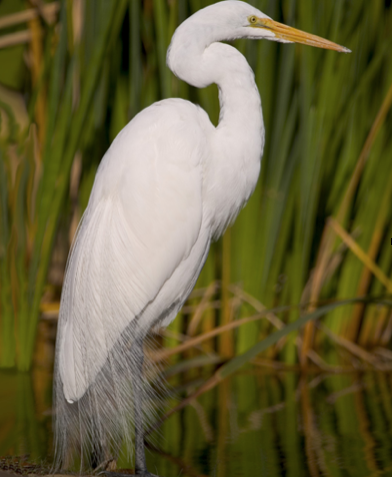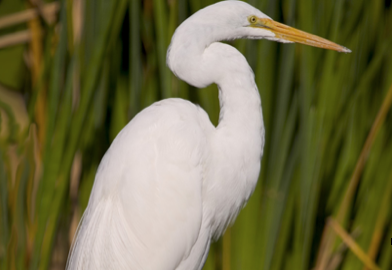Great Egret (Ardea alba), “Great White Heron”

Appearance: white body, long black legs, long S-curved neck, long yellow beak, dark feet (not yellow)
- Males are larger than females, both have ornamental feathers during breeding season
Height: about 3 feet
Wingspan: 51-57 inches
(about 4-5 feet)
Status: least concern, populations are increasing
In the late 1800s, great egrets were nearly hunted to extinction because their white plumage became very popular in the fashion industry.
The great egret is the organizational symbol for the National Audubon Society, one of the oldest bird conservation groups in the United States.
- Habitat
- Found in almost all areas of the world
- Found in estuaries (coastal) and wetlands (inland)
- Habitat range in North America is from east coast U.S. to California to Mexico
- Live year-round on East Coast from Delaware to Florida, Gulf Coast, coastal California, and coastal Mexico
- Non-migratory populations also found on tropical islands
- Over decades, the range of great egrets has been shifting north, and the southernmost populations are declining in size
- Dredging, pollution, and clearing of marshes negatively affect this species
- However, they are not as threatened as some other species of egrets because they have a very flexible range
- Diet
- Wade through shallow water, stand and wait until prey swims by
- Use dagger-like beaks to quickly strike prey
- Eats mostly fish, but also crustaceans, amphibians, insects, and small mammals
- Most hunting occurs at dawn and dusk, occasionally during the day
- Great egrets may use human-altered habitat to forage such as flooded fields and aquaculture ponds
- Highly aggressive towards other birds when they try to intrude on feeding site
- Migration
- Egrets are primarily migratory, though some populations are non-migratory
- Cruising flight speed is 25 mph, but can fly up to about 35 mph
- Slow but powerful flyers for birds of their size
- In spring and summer, great egrets stray farther inland from their year-round habitat, or they fly up north to New York, New Jersey, and Massachusetts
- Overwintering populations hug the coastline of their year-round territories or travel to mainland California and Mexico
- Outside of breeding season, great egrets hunt alone or in small groups
- Nesting
- Great egrets build stick nests high in trees
- Nests are anywhere from 3 to 100 feet above the ground
- A typical nest is about 3 feet across and 1 foot deep
- Usually roost and nest with other egrets and even other types of wading birds
- Great egrets are usually the first colonizers, other birds later join them
- Form colonies that consist of tens, hundreds, or even thousands of birds
- Early in the breeding season, great egrets grow long feathers on their backs, called aigrettes, which they raise when trying to attract a mate
- Males do most of the displays, but both sexes grow agrettes
- Mate once per year, unknown if breeding pairs from previous years stay together
- Great egrets often return to the same nesting site year after year
- They may reuse the same nest, but this is uncommon
- Average brood is 1-6 pale, greenish-blue eggs
- Chicks are very aggressive, threatening and attacking any intruders to the nest
- Chicks may fight for dominance, which can seriously injure or even kill other chicks (siblicide)
- In years with poor breeding conditions, the parents favor the two or three largest chicks
- Parents care for their young until they are able to fly (after about 30 days)
- Fledglings leave the colony at about 40 to 60 days old
- Great egrets normally live about 15 years, but some may live 20+ years
- Great egrets build stick nests high in trees







